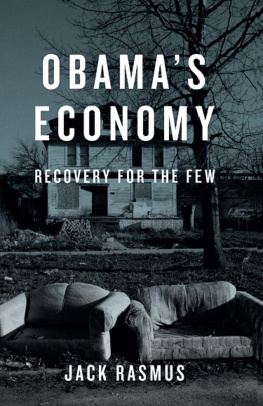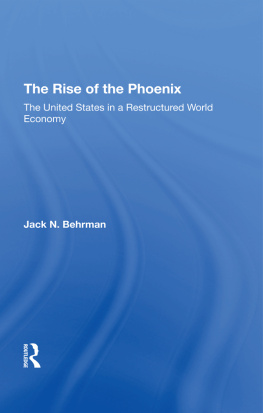First published 2012 by Pluto Press
345 Archway Road, London N6 5AA
www.plutobooks.com
Distributed in the United States of America exclusively by
Palgrave Macmillan, a division of St. Martins Press LLC,
175 Fifth Avenue, New York, NY 10010
Copyright Jack Rasmus 2012
The right of Jack Rasmus to be identified as the author of this work has been asserted by him in accordance with the Copyright, Designs and Patents Act 1988.
British Library Cataloguing in Publication Data
A catalogue record for this book is available from the British Library
ISBN 978 0 7453 3219 2 Hardback
ISBN 978 0 7453 3218 5 Paperback
ISBN 978 1 84964 694 9 PDF
ISBN 978 1 84964 696 3 Kindle
ISBN 978 1 84964 695 6 ePub
Library of Congress Cataloging in Publication Data applied for
This book is printed on paper suitable for recycling and made from fully managed and sustained forest sources. Logging, pulping and manufacturing processes are expected to conform to the environmental standards of the country of origin.
10 9 8 7 6 5 4 3 2 1
Designed and produced for Pluto Press by Chase Publishing Services Ltd
Typeset from disk by Stanford DTP Services, Northampton, England
Simultaneously printed digitally by CPI Antony Rowe, Chippenham, UK and
Edwards Bros in the United States of America
Introduction: A Systemic Crisis of Recovery
The Wasted $12 Trillion
The defining feature of the U.S. economy over the past three years since Obama took office has been its failure to achieve a sustained recovery. After three economic stimulus programs costing $3 trillion over the past three years, 200911, and after more than $9 trillion in bank rescues by the Federal Reserve, the faltering U.S. economic recovery of the past three years is headed toward an eventual double-dip recession by 2013.
The U.S. economy entered recession in December 2007. The decline accelerated in SeptemberOctober 2008 with the onset of the banking crash. The collapse set in motion by the events of SeptemberOctober 2008 continued through the first six months of 2009, at a pace virtually identical to 192930. The economy only bottomed out by June 2009. But bottoming out does not constitute recovery. Nor does the weak and faltering economy that followed the June 2009 bottom.
Recovery means restoring the economy to levels and performance prior to the onset of recession, or at least to some average historical level and performance preceding the collapse. The period from June 2009 to the present therefore cannot qualify as a recovery in either of these cases; nor can it in any otherwise normal sense of the term.
Except for financial asset pricesi.e. stocks, bonds, derivative trades, etc.during the first year, from June 2009 to June 2010, nearly all real (non-financial) economic indicators recovered at best only part of the prior losses of 200809. And critical sectors of the economy, like jobs and housing, recovered virtually nothing. Moreover, many economic indicators that did partially regain some lost ground in the first year after June 2009 thereafter experienced a further relapse in the summer of 2010. Meanwhile, jobs and housing experienced a bona fide double dip. A second partial recovery followed in late 2010, even weaker than the first in 200910. In late 2011, the economy began to fade once more, as a second relapse of the economy once again emerged. This raises the first of three major themes of this book:
What explains this weak, repeatedly faltering economy and failure to achieve a self-sustaining recovery after trillions of dollars in fiscal and monetary stimulus?
By October 2011 an increasing number of economists, and even business sources, began to predict the relapse might soon turn into a double-dip
To the extent there has been any recovery these past three years under the Obama administration, that recovery has been limited to and has benefited a relatively small segment of the U.S. economy and population. After June 2009 stock markets rose more than 100%. Bond markets did even better. Corporate profits exceeded levels even preceding December 2007. U.S. large corporations accumulated more than $2 trillion in cash on hand, while U.S. multinational corporations were able to build a cash hoard of another $1.21.4 trillion in their offshore subsidiaries. Both continue to hoard their more than $3 trillion in cash, not investing it in the U.S. to create jobs and contribute to sustained recovery. Not to be outdone, big banks accumulatedand then also sat onabout $1.5 trillion in excess cash reserves, mostly refusing to lend to smaller businesses to create jobs and assist recovery.
Measuring recovery in terms of its human dimensionnot just in terms of impersonal economic indicatorsyields a similar grossly unbalanced picture: CEO and senior management compensation and bankers bonuses recovered in 2010 to pre-2008 levels. The top 25 hedge fund managers did even better. Their income more than doubled in 2009 to surpass previous 2007 peaks. The wealthiest 10% of households returned to consuming luxury goods at pre-recession levels.
In contrast, more than three years after Obama took office there are still roughly 24 million unemployed. The numbers of part-time and temp jobs have increased by more than 10 million, as full-time permanent jobs are churned out and replaced by part-time and temp jobs with lower pay and hardly any benefits. Thus, not only the number of jobs but the quality and level of pay and benefits associated with jobs has also not recovered. Real weekly incomes for more than 100 million non-supervisory workers are less today than two years ago due to wage cuts, fewer hours of work, and escalating inflation of basic itemslike health care services, education, gasoline, and many basic food costs that have risen at double-digit rates throughout 2011.
In addition to jobs and wage income, home foreclosures have more than doubled in number since early 2009, to 11.4 million by late summer 2011. 17 million homes are underwater, with home values worth less than their mortgages. States and cities continue to lay off workers by the hundreds of thousands in 2010 and 2011, slash vital services and programs, and raise fees at an accelerating pace. Poverty rates in the U.S. are now at their highest levels in half a century, impacting more than 15% of the population (45 million). That includes more than 15 million childrenthe latter distributed more or less evenly across white, latino, and black kids. More than 50 million officiallyand more in factare without any kind of health care coverage. Food stamp usage has more than doubled in the past two years, as has student loan debt in two years. Trillions of dollars of seniors retirement nest eggs have disappeared forever, as Congress in late 2011 nonetheless proposed to reduce their medical and retirement benefits further. The litany of conditions that have worsened is endless. That is not recovery by any stretch of the imagination.
And its not just workers, homeowners, students, and the 100 million plus working- and middle-class households who have not recovered. Hundreds of thousands of small businesses have gone under since the bottom of the recession in June 2009, more failing than are being created, as banks continue to starve them (and households) of basic loans and credit as the banks continue hoarding more than $1 trillion in cash reserves on hand. Even banks themselves have been divided into haves and have-nots. The too big to fail largest 20 or so banks have in part recovered, propped up by $9 trillion in U.S. Federal Reserve liquidity injections, zero-interest loans and direct subsidies, and hundreds of billions in direct grants from the U.S. Treasury and taxpayers. Meanwhile, more than 500 small community and regional banks have either failed outright or have been forced into mergers by government regulators to protect what little depositors assets remain on their books. In short, a small layer of wealthy households, professional speculators and investors, big banks and multinational corporations, CEOs and senior managers, have indeed recovered. But virtually no one else. The preceding undisputable facts lead to the second major theme of the book:










